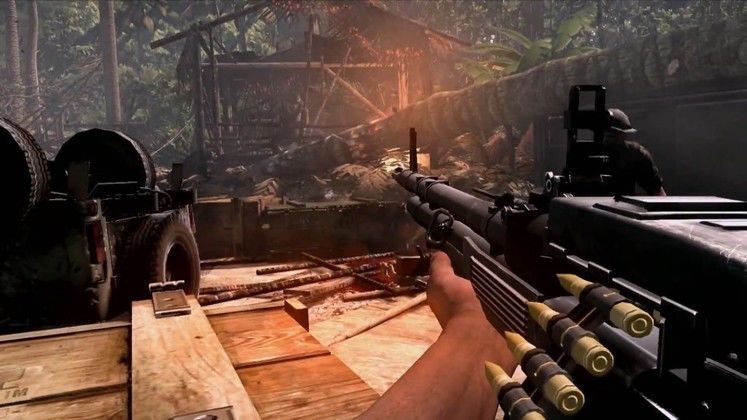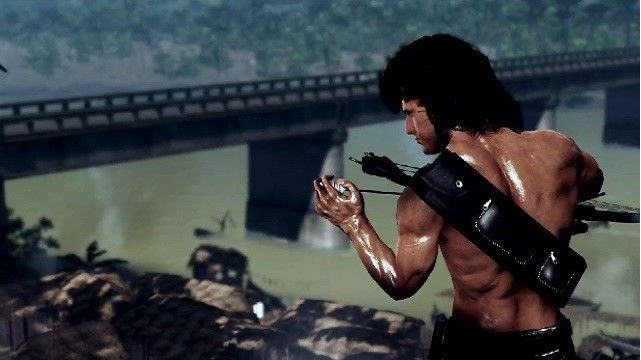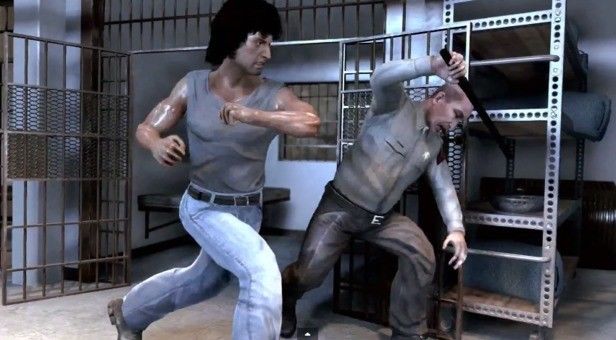“I’m a crack shot at this,” says Marty McFly as he steadies his pistol in front of the Wild Gunman arcade cabinet in the Cafe 80s. As the game begins, he shoots off three quick-fire rounds, and the three on-screen poncho-donning antagonists are laid flat on their backs. “CRACK SHOT!” heads the display. “You mean you have to use your hands?” scoffs the futuristic juvenile Marty had so eagerly hoped to impress with his light-gun prowess. “That’s like a baby’s toy.”
 |
| Not enough variety, even when in control of powerful weapons |
Now, I can’t say for sure how videogames will be enjoyed by next year, but I think it’s safe to assume we’ll still require our hands to use them, regardless of the operational similarities to that of babies’ playthings. Not that I lack faith in Back to the Future 2’s interpretation of how life will be in 2015, but it’s pretty clear that this scene was trying to convey the notion that certain things from certain eras can and do become outdated over time; the apt example here being videogames. For me, both Rambo and rail-shooters fall into this category.
Rambo: The Video Game is one of those first-person, rail-shooting, points-accumulating games and is based on, you guessed it, the Rambo series of movies. As mentioned above, it’s only based on the first three: First Blood (1982), Rambo: First Blood Part II (1985), and Rambo III (1988) - there is no sign of the poorly received 2008 endeavour, which is almost definitely a good thing. So, essentially what we have is a game based on a film franchise over a quarter of a century old, depicted by a genre of gaming which hasn’t been bettered since Time Crisis 2 found its way into video arcades back in 1998.
To put this into chronological perspective, the Rambo original trilogy reached its end five months prior to the release of Super Mario Brothers 2 for the NES in 1988. Why is this significant? Well, what I can’t get my head around is why we are getting a Rambo videogame now - six years after what appears to be the conclusion of the film series - based solely on movies from the 1980s, operating a horribly outdated first-person rail-shooter style. Yes, over time Rambo (and Stallone, for that matter) has achieved cult status within pop culture, however considering the fact that 2008’s ‘Rambo’ sold less at the box office than any of its 80s counterparts, surely suggests that the character is losing its appeal, regardless of how much revenue the franchise has amassed since inception.
Had Rambo: The Video Game shocked, awed and wowed us, all of this may not have been entirely important. Unfortunately, it fails to do any of the above. By opting for a rail-shooter style, Rambo: The Video Game depicts scenes from the first three movies as brief, action-packed set pieces which serve up generic backdrops and generic bad guys for slaughter from start to finish, as if powered by an invisible conveyor belt. As a result, each ‘scene‘ feels rushed, lacking the cohesion needed to link it to the next, which better player agency - say, if the game were a first person shooter - would almost definitely have set straight. Each scene, then, feels more like a montage of events; an homage to each movie, as opposed to a retelling - which is ultimately what the game is trying to achieve. Even supposing this has been done ironically, or as satirical meta-humour - for we all know how much Stallone loves an 80s-style montage - it’s still very jarring and at times grinding.
 |
| The game is at its best with the bow and arrow |
The problems tied with rail-shooting don’t end there. Too often control is completely robbed from the player, as dodgy camera work regularly results in complete disorientation. Even the genre’s core mechanic - ducking and covering - is hit or miss, depending on whether or not each scene feels like incorporating it. That tree you were hiding behind earlier? Yeah, you can’t hide there anymore until you take out those five Vietnamese soldiers, and whilst you reload they’ll continually shoot at you point blank. Adopting a similar mechanic to Sierra’s 2006 Scarface videogame, health regeneration is only possible when in ‘Wrath’ mode, where Rambo hits a bit of a flaky and accumulates vitality by slaughtering any of the temporarily glowing foes in his line of sight. This demands economical use of the power-up, wherein a bar charges with each kill until full, however once activated, it can’t be stopped. This becomes a problem when the game once again steals camera control or an unexpected QTE is thrown at you, unfairly denying you the chance to finish your kill-streak.
QTEs present yet another issue. Unless played on the easiest setting, the game’s QTEs are at times unrelenting and often so clunky that button mashing trumps finesse. In an almost premonitory move, the game itself provides an unlockable skill which renders the player invincible to QTEs - the only downside being that in turn they are provided with less skill points used to unlock other perks. Certain missions attempt to utilize QTEs in stealth mode as Rambo stalks enemies armed with just a blade, however, again, the game-on-rails infliction dilutes any sort of atmosphere or tension.
Aside from varying reloading times - activated manually via a side gauge, whereby ammo is constantly infinite - each gun feels similar to the last, but by completing ‘Trautman’s challenges’, of which there are 12, more guns can be unlocked. Some set pieces do require a certain level of skill and planning - particularly when using grenades to take out heavy-artillery vehicles. In these more challenging segments devising a plan as to who to gun down first can become essential, and picking out the obligatory gasoline canisters can also be quite entertaining. Other levels see Rambo in charge of a bow and arrow. These occasions demand the most skill and concentration from the player and, although the bow can be reused in regular combat after its first appearance, it’s a shame these particular stealth influenced segments don’t feature more often.
 |
| QTEs are frustrating and tedious |
Much like the movies, Rambo: The Video Game may not be taking itself entirely seriously throughout its two to three hour duration, but nonetheless it is hard not get frustrated at its lack of depth in so many areas. A co-op mode can be activated if you have access to a PC-friendly Xbox controller, however even this mode feels like it’s been done better elsewhere in the past - not least in SNK’s 1986 Rambo-a-like, Ikari Warriors.
Rambo: The Video Game is clearly a cash-in, but one that makes little sense, with little relevance. The film fanatics may well find enough here to be entertained for more than ten minutes at a time, if for nothing else but to don the virtual red bandana, but I struggle to see how this interpretation could be any better than popping onto Netflix and watching the real thing. You could even then don an actual red bandana, if that’s what you’re into.
“Nothing is over! Nothing! You just don't turn it off!” said John Rambo in First Blood. As far as the videogame is concerned, I’m sorry mate, I just don’t agree.
RAMBO: THE VIDEO GAME VERDICT
“Nothing is over! Nothing! You just don’t turn it off!” said John Rambo in First Blood. As far as the videogame is concerned, I’m sorry mate, I just don’t agree.
TOP GAME MOMENT
Playing William Tell with enemy soldiers in the jungle.




